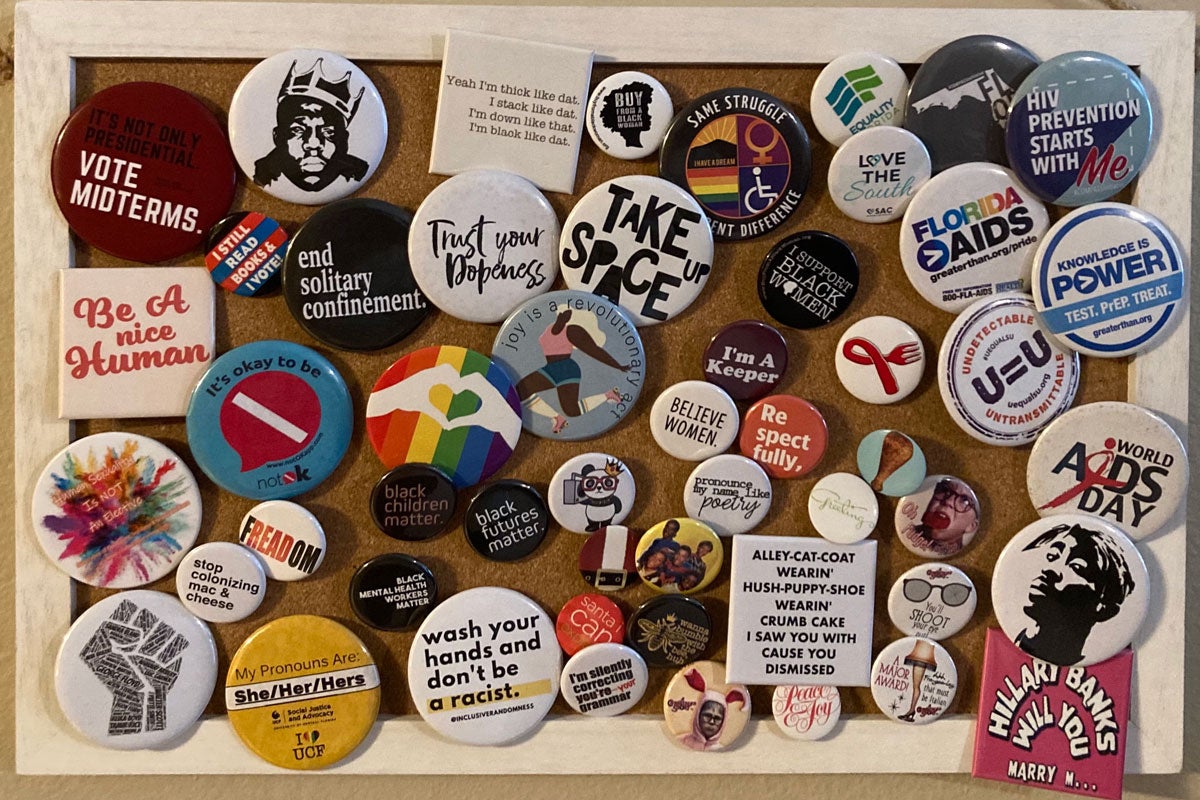I have worked in education for quite some time, and I am dedicated to using just about anything as an instructional tool. Current events, multimedia clips, song lyrics, memes — these are all ancillary materials that I will use to engage students and make content interesting and relevant. And I love a good object lesson; I once used a Slinky to explain hair textures to high school students in a multicultural class.
Again, I will use just about anything as an instructional tool. My newest tools: buttons and lapel pins.
I have a nice button collection. It includes funny buttons, like the one that says, “I’m silently correcting your grammar,” and another that depicts a 1980s-inspired panda carrying a boombox. Other buttons are more serious, with declarative statements like, “Believe Women,” “Black Children Matter,” and “End Solitary Confinement.” I have a button that encourages people to “Vote Midterms,” and a button that combines humor and politics, stating, “I still read books and I vote.”
Many of my buttons are inspired by popular culture, with images of Tupac and New Edition, or movie quotes such as “Blues in your left thigh,” a line taken from the movie Love Jones. Among my collection of holiday buttons are ones that reference the cult classic A Christmas Story — and yes, one of them says: “You’ll shoot your eye out.”
Several of my buttons focus on HIV, and three other buttons, purchased from the Holocaust Museum in Washington, D.C., remind us of a harrowing past while cautioning us to never again allow hatred to rule.
I collected buttons when I was young and have revived the practice in recent years. It has become my thing. I scout out buttons when I travel and order them from various small businesses online. Friends have given me buttons and lapel pins because they have seen my collection. I cherish them all.
Initially, I wore them to accent my outfits, but now I often decide what clothes to wear based on the button I select for that day. A student’s comment during a class discussion transformed my button-wearing from simply a means of personal expression to an intentional point of engagement around meaningful topics.
It was late November in the class I teach on law and ethics for future school counselors. We were reviewing important lessons from the semester and had spent some time discussing advocacy methods in schools. One student began to share her thoughts about how, as future school counselors, they could create safe and welcoming environments for all students. The class was listening intently as she shared her ideas, but we all broke into laughter when she gestured toward me and referenced my buttons as a way to communicate important messages.
Our laughter came as we nodded in affirmation of her point while also acknowledging the current button I was wearing. It was a turkey leg. Thanksgiving was only a few days away, so I had selected a button with less meaning and more levity as we prepared for a long weekend and approached the end of the academic term. The turkey leg button brought a moment of humor, but it also showed me that students pay attention…to everything…even buttons and lapel pins.
I had never offered an explanation about my button-wearing; had not explicitly connected it with advocacy. On occasion, I might have drawn attention to a button to make a point, but usually I allowed the buttons to stand on their own. Observing that they did, in fact, stand out and attract attention, I have been more thoughtful about the buttons I purchase and when I wear them.
On the first day of class, I wear one of three pronoun buttons to communicate the importance of using the proper pronouns for people and to make space for students to share their pronouns. I have an “It’s ok not to be ok” button that I wear when talking about suicidal ideation and self-harm among children and adolescents. I wear my “Trust Your Dopeness” button on the first day of practicum as encouragement to my counseling students serving real clients for the first time. Recently, for my Human Sexuality class’s discussion of sexuality across the lifespan, including late adulthood, I wore a button that paid homage to the Golden Girls.
Not all of my buttons are directly related to course content. Some I wear just to reflect my mood on a particular teaching day. When I am feeling sentimental, I wear the rainbow pin that says “Jackie” to feel close to my mother. Others I wear on specific dates that are related to the buttons. On November 16, I plan to wear the “If folks wanna pop off” button to mark one of President Obama’s more transparent moments from 2015.
My hope is that the buttons and lapel pins punctuate the course content and enrich the learning experience. If nothing else, they are talking points that invite my students to see me as human. Sometimes, that’s the only lesson.
J. Richelle Joe is an assistant professor of counselor education in the UCF College of Community Innovation and Education. She can be reached at jacqueline.joe@ucf.edu.
The UCF Forum is a weekly series of opinion columns from faculty, staff and students who serve on a panel for a year. A new column is posted each Wednesday on UCF Today and then broadcast on WUCF-FM (89.9) between 7:50 and 8 a.m. Sunday. Opinions expressed are those of the columnists, and are not necessarily shared by the University of Central Florida.




